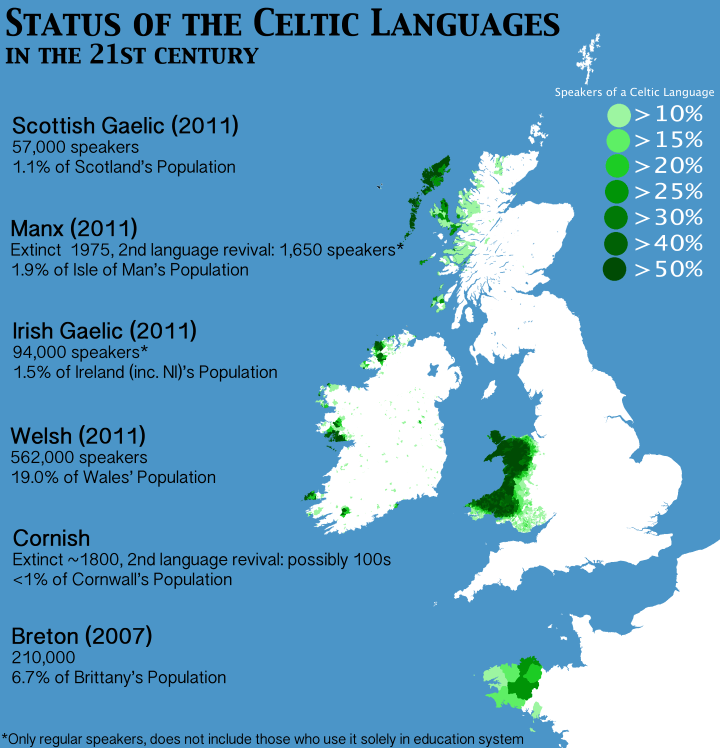Celtic languages (such as Irish Gaelic, Scottish Gaelic, and Welsh) still play an important role in the modern world. Although these languages are not as widely used as others, like English for example, they are still used regularly by the regions they are associated with. In this blog we will look into the way the modern world uses the Celtic languages.
The map below will give you a better idea of the existing Celtic languages and how they are spread in the 21st Century.

Irish Gaelic is actually the first official language of the Republic of Ireland and one in five people can speak it, and one in twenty use it daily. Although this is primarily in Ireland alone, it shows that the language plays a key role in establishing and maintaining Irish traditions and identity. The preservation of Irish Gaelic is seen in the continued teaching of the language (it is a compulsory subject in first and middle schools), thus showing that it is deemed important enough for the younger generations to continue to learn and to use Gaelic. Some may argue that as it is taught in schools, it makes it an official language and should be recognised as such.
The Scottish Gaelic language is considerably less common, when compared to the Irish Gaelic, as it has been named an endangered language, despite its resurgence in recent years. Scottish Gaelic is an indigenous language that unfortunately doesn’t have a high level of daily usage. However, it is still a significant element to many Scottish people as 60,000 people, out of population of five million living in Scotland, can speak it. Despite its lack of popularity in the Scottish region, there is a large variety of online resources to assist those wanting to learn the language, suggesting that it is still a useful language to know when dealing with the Scottish regions especially as it has been gradually growing in popularity in recent years.
Welsh has consistently been a common and popular language within Wales with a large variety of daily uses, such as place names. Additionally, it is also possibly one of the oldest languages that is still used, dating back roughly four thousand years, and it managed to survive the banning of the language in 1536 (as a result of Henry VIII’s Act of Union) and the influx of English into Wales during the Industrial Revolution, which resulted in the work places becoming predominantly English speaking. Only in recent years has it made a considerable comeback as a result of the 1964 radio broadcast titled ‘Tynged Yr laith’ (which translates to ‘The Fate of the Welsh Language’). As to the question of ‘is it an official language?’, people may argue that it is as the Welsh Language Bill of 1992 stated that the Welsh language was to be treated as an equal to the English language, thus showing its importance and official status. It is easy to see the importance of Welsh for the younger generations as it is a compulsory subject until the age of sixteen and every teacher in Wales had been taught at least the very basics during their training period. In modern day rural Wales, the Welsh language is still very prevalent and so is useful to know when dealing those who live in those areas.
Although the Celtic languages we’ve discussed in this blog do not have the same level of popularity and common practice as they did many years ago, they clearly still hold great significance in modern life.
Whether you want to find more about your family history or translate any documents from Irish Gaelic, Welsh, Scottish Gaelic into English, TranslationsInLondon can assist you.

